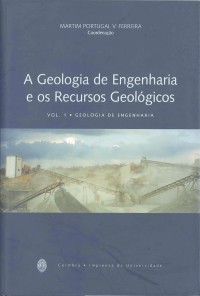Please use this identifier to cite or link to this item:
https://hdl.handle.net/10316.2/39156| Title: | Georrecursos ambientais da Península de Setúbal: um processo participado de estudo e classificação de património geológico | Other Titles: | Environmental georesources in the Península de Setúbal: a case study of partnership on learning and classification of geological heritage | Authors: | Kullberg, J. C. Caetano, P. S. Rocha, R. B. Rocha, M. S. |
Keywords: | geological resources;geological heritage;Setúbal;ciência viva;georrecursos;património geológico;Setúbal;ciência viva | Issue Date: | 2003 | Publisher: | Imprensa da Universidade de Coimbra | Journal: | http://hdl.handle.net/10316.2/2826 | Abstract: | In the frame of the Ciência Viva Programme of the Ministério da Ciência e do Ensino Superior, the Applied Geosciences Research Centre of the UNL coordinated, during the years 2000/2001 to 2002/2003, a project entitled “Study and classification of environmental georesources of the Setúbal Peninsula”. The institutions envolved in this project, besides the coordinator, were six basic and secondary level schools from the councils of Seixal, Barreiro, Setúbal and Sesimbra, the respective Municipalities, the Arrábida Natural Park (PNA) and an NG environmental association from Sesimbra (NECA). The work developed counted with the participation of around 20 teachers and researchers, 500 students, monitors from NECA and technicians from the Municipalities and PNA.
The main objectives of this project were to promote the awareness of both students and parents to issues related to the valorization and conservation of the surrounding Natural Heritage, the motivation of the students to the necessity of supporting Natural Heritage protection measures, in harmony with development, and the development of an ecological conscience, in order to contribute to the formation of responsible citizenship.
Following specific geological methodologies, the students proceeded to the gathering of information and field samples from various sites with geological interest within the Setúbal Peninsula. This led to the development of synthetic reports on each of the studied sites for incorporation in multimedia support, and proposals of explanatory panels to be placed on site. In addition to the objectives mentioned above, this work has provided the local authorities, the Arrábida Natural Park, and other competent entities, with scientific and educational instruments containing conservationist recommendations, which will help and support future decisions made on the classification of geological monuments and creation of natural itineraries. No âmbito do Programa Ciência Viva do Ministério da Ciência e do Ensino Superior, o Centro de Investigação em Geociências Aplicadas da UNL coordenou, durante os anos lectivos 2000/2001 a 2002/2003, o projecto intitulado “Estudo e classificação dos georrecursos ambientais da Península de Setúbal”. Para além da instituição coordenadora participaram seis escolas dos ensinos básico e secundário, pertencentes aos Concelhos de Seixal, Barreiro, Setúbal e Sesimbra, as respectivas Câmaras Municipais, o Parque Natural da Arrábida (PNA) e uma associação de intervenção ambiental da região de Sesimbra (NECA). Os trabalhos realizados contaram com a participação de cerca de 20 docentes e investigadores, cerca de 500 alunos, monitores do NECA e técnicos das Câmaras Municipais e PNA. Os objectivos principais do projecto foram a sensibilização dos alunos e pais para questões relacionadas com a valorização e conservação do Património Natural do meio envolvente, a motivação dos alunos para a necessidade da protecção do Património Natural, em harmonia com o desenvolvimento e o fomento de uma consciência ecológica, de modo a contribuir para a formação de um cidadão responsável. Os alunos procederam à recolha de informação e de amostras de campo em vários locais de interesse geológico na Península de Setúbal, utilizando as metodologias próprias da Geologia. Foram depois elaboradas informações síntese sobre cada um dos locais, para incorporação em suporte multimédia e propostas de cartazes explicativos para colocação in situ. Além dos objectivos já assinalados foi, assim, possível dotar as autarquias da região, o Parque Natural da Arrábida e outras entidades competentes, de instrumentos de carácter científico e pedagógico, com recomendações de carácter conservacionista, que suportem futuras decisões sobre a classificação de geomonumentos e a criação de itinerários naturais. |
URI: | https://hdl.handle.net/10316.2/39156 | ISBN: | 972-8704-14-3 978-989-26-0321-6 (PDF) |
DOI: | 10.14195/978-989-26-0321-6_20 | Rights: | open access |
| Appears in Collections: | A geologia de engenharia e os recursos geológicos. Vol. I: Geologia de Engenharia |
Files in This Item:
| File | Description | Size | Format | |
|---|---|---|---|---|
| georrecursos_ambientais_da_peninsula_de_setubal.pdf | 3.52 MB | Adobe PDF |  |
Items in DSpace are protected by copyright, with all rights reserved, unless otherwise indicated.
